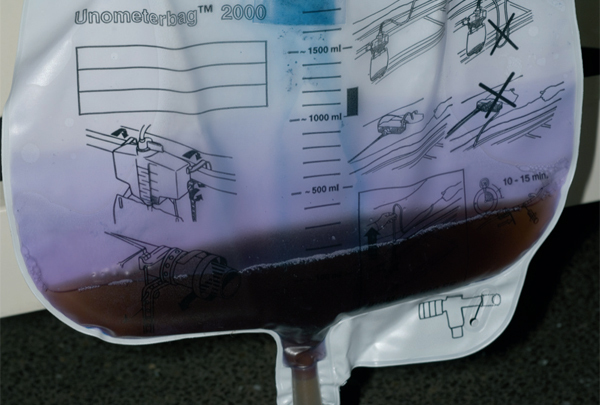To the Editor,
Purple Urine Bag Syndrome is very rare, but extremely distinctive given its clinical signs. A change in urine colouration occurs, turning it purple. This happens in very specific situations: when patients with a urinary catheter have multiple disorders and are suffering from a urinary tract infection caused by certain germs.
We present the case of a 78-year-old woman with a history of high blood pressure. She was treated for hydronephrosis secondary to lithiasis of the left kidney. A few months before the current episode, she was admitted to hospital due to a wasting syndrome and abdominal distension. Peritoneal carcinomatosis was observed in an ultrasound and an abdominal computerised tomography (CT). The ascitic fluid cytology was compatible with adenocarcinoma. We performed an upper gastrointestinal endoscopy and colonoscopy, which were normal. The biochemical blood test showed a noticeable increase in the CA 125 tumour marker, which was indicative of metastatic adenocarcinoma, likely to be of ovarian origin.
The patient came to the emergency department with sub-acute oedemas in her limbs. Her abdominal girth increased, and she presented with oliguria and progressive dyspnoea on minimal effort. No dietary or pharmacological transgressions had occurred, nor did the patient present with any type of infection. When the patient was examined, her blood pressure was 95/55mm Hg, heart rate was 90bpm and oxygen saturation measured by pulse oximetry was 90%, with FiO2 at 35%. The central venous pressure had not increased, heart auscultation was rhythmic without murmurs and lung auscultation revealed disperse bilateral wheezing. The abdomen was distended with signs of tense ascites, and palpable masses were found at different levels. She presented with pitting oedemas on the middle third of both legs but had no signs of deep vein thrombosis. Neurologically, she was conscious and aware of her surroundings, and showed no signs of flapping tremor.
The analysis showed: Cr: 4.3mg/dl; Na: 125mEq/l; K: 6.99mEq/l; Cl: 104mEq/l; liver biochemistry and LDH tests were normal; total proteins: 6.4g/dl; and albumin: 2.8g/dl; pH: 7.28; pCO2: 50mm Hg and bicarbonate: 24mmol/l. The haemogram analysis showed that she had 15 100 leukocytes with neutrophilia and normocytic-normochromic anaemia, which was already known. Coagulation was normal. The chest X-ray showed signs of heart failure, and the abdominal ultrasound confirmed the presence of abundant ascites and several masses on the abdominal wall. Hydronephrosis was not observed, nor was there any sign of obstructive nephropathy. No clear lesions were found on the ovaries.
The patient was admitted, diagnosed with acute renal failure related to volume depletion in context of oedema and ascites decompensation secondary to peritoneal carcinomatosis, likely to be of ovarian origin. Under depletive treatment, her clinical evolution was favourable, correcting her renal and ion regulating functions. A urinary catheter was inserted to monitor diuresis. A few days after hospital admission, purple urine was observed in the drainage bag (Figure 1). The patient had not a fever, was haemodynamically stable and asymptomatic. Blood tests were repeated, but they did not show any new relevant alterations and a biochemical urine test was performed, showing a pH of 9, microhaematuria, pyuria and abundant bacteria. A sample was extracted for a urine culture in which more than 105 colony-forming units for Klebsiella pneumoniae and Proteus mirabilis were isolated. The patient was administered antibiotic treatment in accordance with the antibiogram results (1g of amoxicillin and clavulanic acid every 8 hours). Clinical evolution was favourable, and the urine colour gradually cleared. After three days it had a normal appearance.
These clinical symptoms are known as purple urine bag syndrome, which is very rare. It was first described in 1978.1-5 It develops more frequently in older women,2 who have permanent or long-term urinary catheters,3 in patients with chronic renal failure,4 bedridden patients or those affected by chronic constipation.5 The clinical symptoms consists of a noticeable change in urine colour, to blue and purple tones, and is often associated with lower urinary tract infections. Its aetiopathogenesis is not well known, but it is believed that it is due to ingesting tryptophan rich foods, which transform into indole due to the bacterial flora’s action. This is then absorbed by the portal system to later be excreted by urine. In this case, due to action of bacteria able to produce sulphatase and phosphatase enzymes,5,6 they transform into indigo (which is blue) and indirubin (which is red),7 turning the urine this colour. These chemical reactions especially occur in alkaline urines,2,8 although a case in acidic urine has also been described.9 Bacteria most associated with this process are: Providencia spp., Escherichia coli, Proteus spp., Pseudomonas spp., Klebsiella pneumoniae, Morganella sp. and enterococci.1,5,8 It is a benign entity that does not often put the patient’s life in danger, nor does it require aggressive treatments. The urine normally clears and returns to its usual colour when the bacteriuria has been resolved and the urine has been acidified.10
Figure 1. Purple urine in the drainage bag







